
The Regional Municipality of York, also called York Region, is a regional municipality in Southern Ontario, Canada, between Lake Simcoe and Toronto. The region was established after the passing of then Bill 102, An Act to Establish The Regional Municipality of York, in 1970. It replaced the former York County in 1971, and is part of the Greater Toronto Area and the inner ring of the Golden Horseshoe. The regional government is headquartered in Newmarket.

The Ontario Provincial Police (OPP) is the provincial police service of Ontario, Canada. The OPP patrols provincial highways and waterways; protects provincial government buildings and officials, with the exception of the legislative precinct; patrols unincorporated areas in northern Ontario; provides training, operational support, and funding to some Indigenous police forces; and investigates complex or multi-jurisdictional crimes across the province. The OPP also has a number of local mandates through contracts with municipal governments and First Nations, where it acts as the local police force and provides front-line services.

Whitchurch-Stouffville is a town in the Greater Toronto Area of Ontario, Canada, approximately 50 km (31 mi) north of downtown Toronto, and 55 km (34 mi) north-east of Toronto Pearson International Airport. It is 206.22 km2 (79.62 sq mi) in area, and located in the mid-eastern area of the Regional Municipality of York on the ecologically-sensitive Oak Ridges Moraine. Its motto since 1993 is "country close to the city".
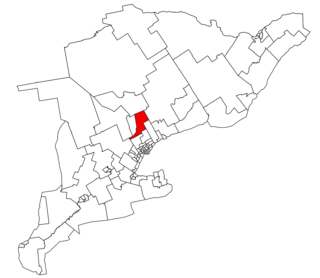
York North was a federal riding in Ontario, Canada, that was in the House of Commons of Canada from Confederation in 1867 until 2004.

York—Simcoe is a federal electoral district in Ontario, Canada, that has been represented in the House of Commons of Canada from 1968 to 1979, from 1988 to 1997 and since 2004.

The Peel Regional Police (PRP) provides policing services for Peel Region in Ontario, Canada. It is the second largest municipal police service in the Greater Toronto Area in Ontario, and the third largest municipal force behind the Toronto Police Service, with 2,200 uniformed members and close to 875 support staff. The Peel Regional Police serve approximately 1.48 million citizens of Mississauga and Brampton, located immediately west and northwest of Toronto, and provides law enforcement services at Toronto Pearson International Airport which annually sees 50 million travelers. Although it is part of the Region of Peel, policing for the Town of Caledon which is north of Brampton, is the responsibility of the Ontario Provincial Police (OPP).

The Toronto Police Service (TPS) is a municipal police force in Toronto, Ontario, Canada, and the primary agency responsible for providing law enforcement and policing services in Toronto. Established in 1834, it was the first local police service created in North America and is one of the oldest police services in the English-speaking world.

The Ottawa Police Service is the municipal police service of Ottawa, Ontario, Canada, as well as most of the Ontario side of the National Capital Region. The OPS employs 1,480 officers and 620 staff as of 2022, and serves an area of 2,790 square kilometres and 1,017,449 people, alongside several other police forces which have specialized jurisdiction. Formally established in 1855, the OPS gradually absorbed the police forces of other neighbouring municipalities as Ottawa itself expanded, and experienced multiple mergers and reforms in the process; the current OPS was established in 2001.
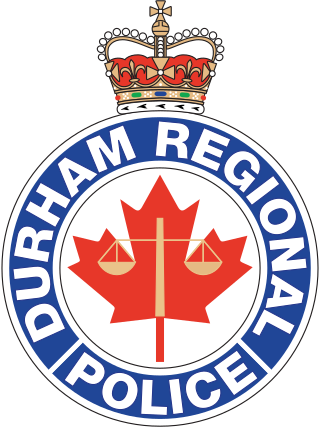
The Durham Regional Police Service (DRPS) is the police service operated by and serving the Regional Municipality of Durham, Ontario, Canada. The DRPS has a strength of over 900 sworn officers and over 300 unsworn members, and serves the following local municipalities, with a combined population of 706,200:
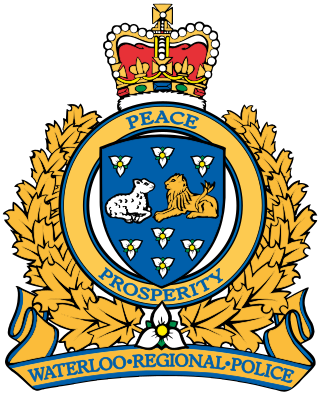
The Waterloo Regional Police Service (WRPS) provides policing services for the Regional Municipality of Waterloo in Ontario, Canada, which encompasses the cities of Waterloo, Kitchener, and Cambridge, as well as the townships of North Dumfries, Wellesley, Wilmot and Woolwich. The WRPS was established in 1973, to replace the individual police departments in the region. The cities of Kitchener, Waterloo and Galt; the towns of Preston, Hespeler, Elmira and New Hamburg; the Village of Bridgeport and Waterloo Township had their own respective police department. The townships of Woolwich, Wellesley, Wilmot and North Dumfries were under the jurisdiction of the Ontario Provincial Police. In 1991 the Waterloo Regional Police Force was renamed to their current name.

The Hamilton Police Service (HPS) is the police service of the city of Hamilton, Ontario, Canada. As of 2021, the service employed 829 sworn officers and 414 non-sworn staff, serving a population of about 570 000 residents. The service's headquarters are located at 155 King William St., Hamilton, Ontario. As of 2022, the service's budget is $183 542 539, roughly 18.5% of the City's overall budget. It is one of the oldest police forces in Ontario.

Law enforcement in Canada is the responsibility of police services, special constabularies, and civil law enforcement agencies, which are operated by every level of government, some private and Crown corporations, and First Nations. In contrast to the United States or Mexico, and with the exception of the Unité permanente anticorruption in Quebec and the Organized Crime Agency of British Columbia, there are no organizations dedicated exclusively to the investigation of criminal activity in Canada. Criminal investigations are instead conducted by police services, which maintain specialized criminal investigation units in addition to their mandate for emergency response and general community safety.
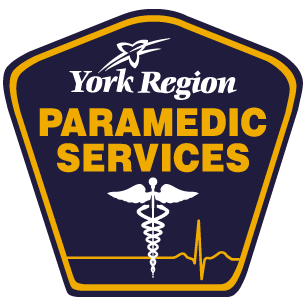
York Region Paramedic Services provides legislated land ambulance services and paramedic care for the local municipalities within York Region. Paramedic Services is a division of the Region's Paramedic and Seniors Service Branch. Prior to 2000, ambulance services were provided by 2 private operators, York County Hospital, Nobleton Volunteer Ambulance and Ontario's Ministry of Health. The patchwork of service also had York Region dispatched by 3 different Ministry of Health Communication Centres. Georgian CACC now dispatches the whole region on the Ontario Government leased Bell Mobility Fleetnet VHF trunked radio system. There are approximately 480 full-time paramedics serving the region. Paramedic Operations are based in East Gwillimbury, Ontario.
Fire services in the York Region of Canada are provided for and by each municipality. There are 35 fire stations across the region. Most services consist of full-time members, but some services have volunteer firefighters.
York Regional Council is the political body for the Regional Municipality of York in Ontario, Canada. Created in 1970, it consists of 21 elected representatives plus the Regional Chair. The elected members are the mayors of each of its nine municipalities, as well as an additional eleven Regional Councillors from the more populous municipalities—four from Markham, three from Vaughan, two from Richmond Hill and one each from Georgina and Newmarket. These members are elected via double direct election.
Elections in the Regional Municipality of York of Ontario, Canada were held on 25 October 2010 in conjunction with municipal elections across the province. The results below are unofficial, pending review from the respective clerk's office for each municipality. Each elected representative becomes a member of York Regional Council.
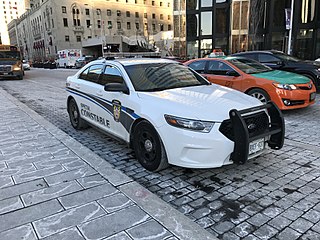
A special constable or special police constable can refer to an auxiliary or part-time law enforcement officer or a person who is granted certain (special) police powers.

The Kingston Police is the municipal police force for the city of Kingston, Ontario. It was established by the Common Council of Kingston on December 20, 1841, making it one of the oldest police forces in Canada. Today, the Kingston Police is made up of approximately 300 members serving an area of 451.58 square kilometers and 132,485 people.

Elections in the Regional Municipality of York of Ontario, Canada were held on October 24, 2022, in conjunction with municipal elections across the province.














































